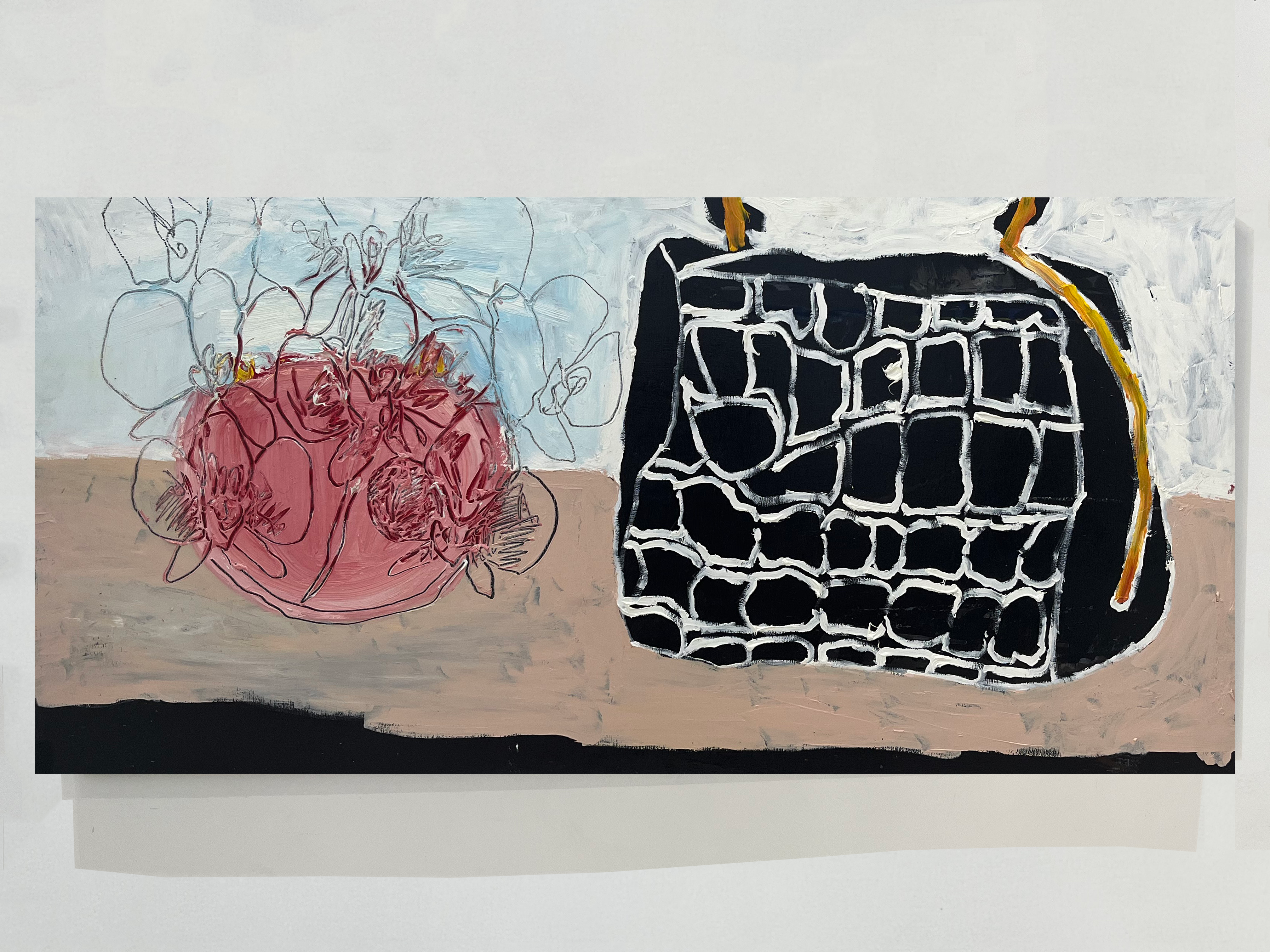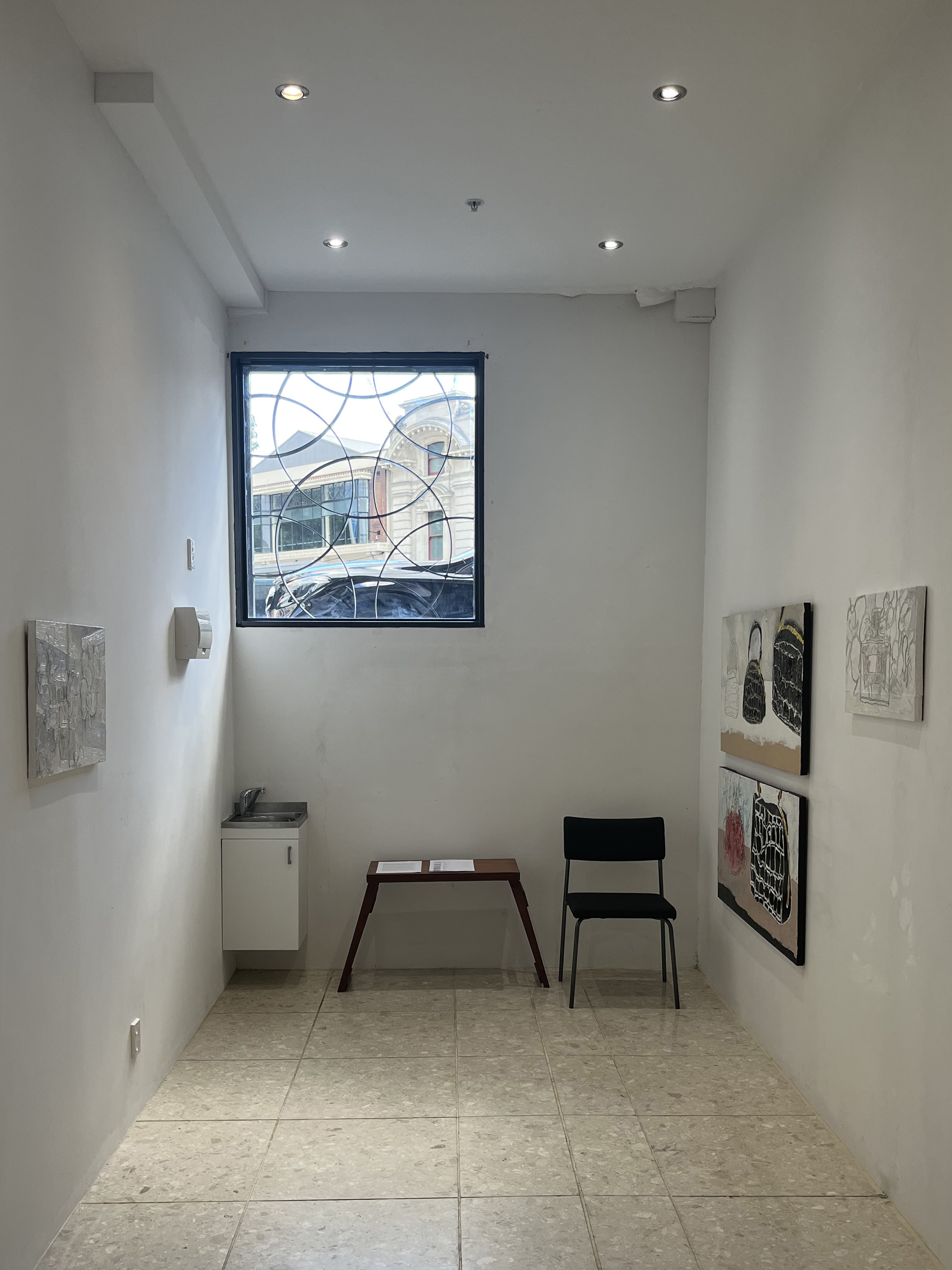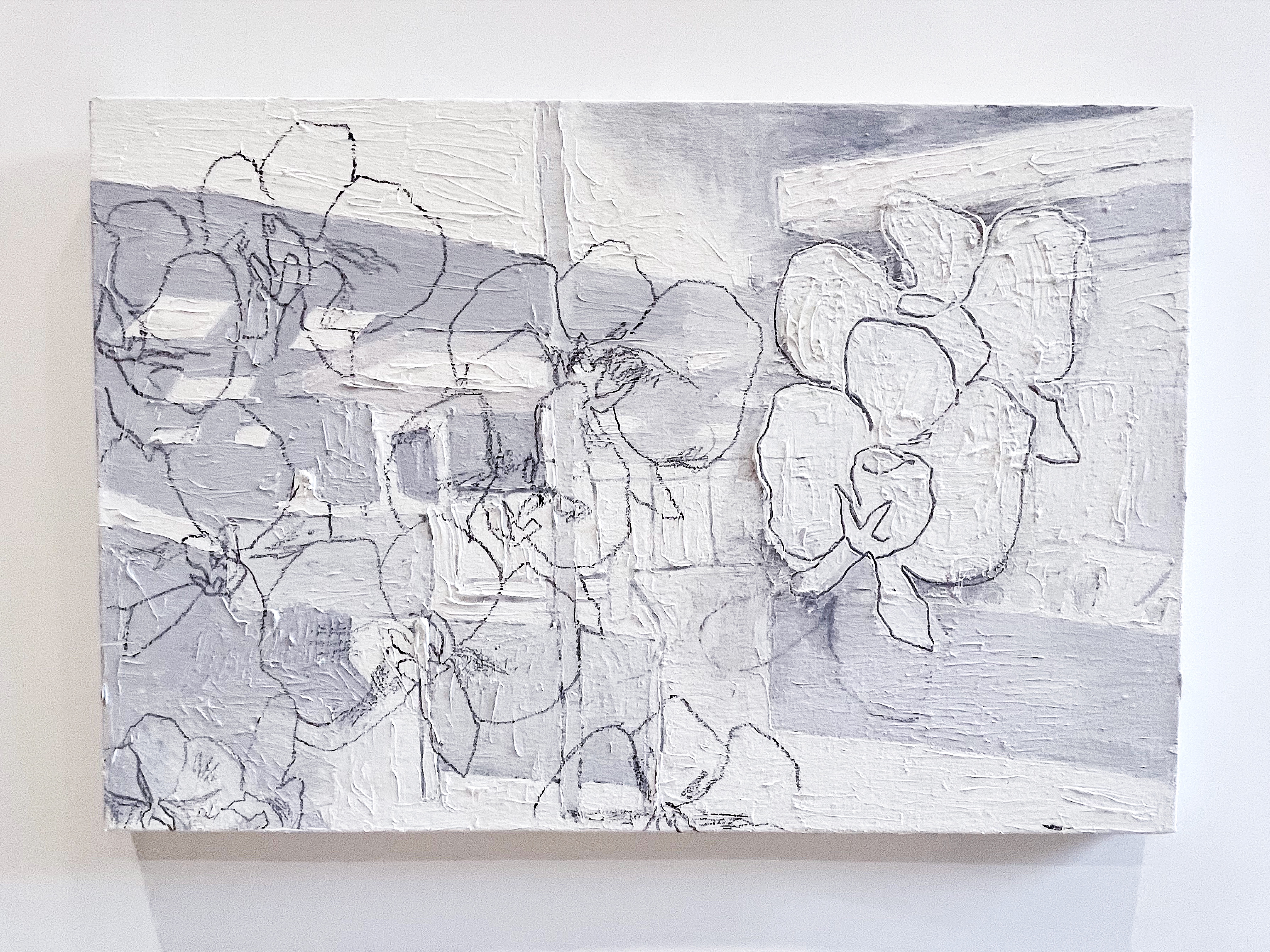
Transcripts: JJ Harper, LOVER <3
Theo Macdonald talks to JJ Harper about LOVER <3, a new artist-run initiative in Tāmaki Makaurau
Transcripts | JJ Harper, LOVER <3 | Tāmaki Makaurau
27.03.22 | written by Theo Macdonald
Transcripts is a series of interviews conducted by Theo Macdonald originally for 95bFM’s Artbank programme, transcribed for Vernacular.
Listen to the recorded interview on Artbank.
This interview was conducted on Wednesday, February 23rd, 2022.
Aired on 95bFM’s Artbank on Sunday, February 27th, 2022.
Theo Macdonald: LOVER <3 opened February 19. How are you feeling about the space now that it is up and running?
JJ Harper: Pretty good. We had a lot of obstacles, and an original date that had to be changed because of circumstances out of my control. I couldn’t have done it without Ben (Martley) and Ursula (Bradley) from Satchi and Satchi and Satchi. They were lifesavers, helping me find a spot and letting me use it. It’s nice to be able to prove to people, based on my previous reputation, that I could do something productive and positive like this.
TM: You’ve opted to operate LOVER <3 as a nomadic space, like Wet Green, or Cuckoo before them.
JH: Or Hapori, which was Sorawit Songsataya and Ayesha Green’s space.
TM: What interests you about that model?
JH: Originally I had a concrete space that I wanted to use, so LOVER <3 is nomadic in the sense that things are up in the air. It seems like I’ll probably be able to use the space that I have now for a while. If things fall apart the space will adapt, and I’ll find somewhere new.
But I was also positioning myself, and this is kind of cringe to say, in a kind of (Wet Green co-founder) Becky Hemus sort of role. Wet Green is very influential on the thing that I’m trying to do. I want to put on shows by my friends and by people that I feel have been underrepresented, and I think that is what Wet Green did. As I am an art writer, it’s not really an artist-run sort of thing.
TM: You are also an art school graduate, and you’ve just won an award at the Eden Art Art Schools Awards, for making an artwork.
JH: But I wouldn’t consider myself an artist.
Theo and JJ laugh.
TM: You alluded to the sort of artists you’re looking to show: people in your social circles, people who you feel haven’t been adequately represented. How would you describe the work that interests you as a gallerist, and as an art writer?
JH: The sort of thing that interests me as a writer is conceptual, and has enough meat on the bone to write about. Most shows I see aren’t worth considering.
This is quite blunt, and probably reveals too much about myself, but as a gallerist I’m looking for things that have some sort of marketability. I’m also looking for something that has a chic contemporary edge to it. Some galleries that I’ve worked at in the past have not had, I feel, enough of that chicness, or contemporariness, to what they are showing. I am also interested in finding artists that I can help to develop their careers from a first or second show into a long-term trajectory.
TM: When you talk about contemporariness, and use terms like “chic,” are you talking about contemporary art with ties to design and tech?
JH: I think it’s a more subjective feeling I haven’t completely locked on to. It’s not like a Simon-Denny-net-art type deal, but it’s a burst of energy, or something like that.
JJ Harper: Pretty good. We had a lot of obstacles, and an original date that had to be changed because of circumstances out of my control. I couldn’t have done it without Ben (Martley) and Ursula (Bradley) from Satchi and Satchi and Satchi. They were lifesavers, helping me find a spot and letting me use it. It’s nice to be able to prove to people, based on my previous reputation, that I could do something productive and positive like this.
TM: You’ve opted to operate LOVER <3 as a nomadic space, like Wet Green, or Cuckoo before them.
JH: Or Hapori, which was Sorawit Songsataya and Ayesha Green’s space.
TM: What interests you about that model?
JH: Originally I had a concrete space that I wanted to use, so LOVER <3 is nomadic in the sense that things are up in the air. It seems like I’ll probably be able to use the space that I have now for a while. If things fall apart the space will adapt, and I’ll find somewhere new.
But I was also positioning myself, and this is kind of cringe to say, in a kind of (Wet Green co-founder) Becky Hemus sort of role. Wet Green is very influential on the thing that I’m trying to do. I want to put on shows by my friends and by people that I feel have been underrepresented, and I think that is what Wet Green did. As I am an art writer, it’s not really an artist-run sort of thing.
TM: You are also an art school graduate, and you’ve just won an award at the Eden Art Art Schools Awards, for making an artwork.
JH: But I wouldn’t consider myself an artist.
Theo and JJ laugh.
TM: You alluded to the sort of artists you’re looking to show: people in your social circles, people who you feel haven’t been adequately represented. How would you describe the work that interests you as a gallerist, and as an art writer?
JH: The sort of thing that interests me as a writer is conceptual, and has enough meat on the bone to write about. Most shows I see aren’t worth considering.
This is quite blunt, and probably reveals too much about myself, but as a gallerist I’m looking for things that have some sort of marketability. I’m also looking for something that has a chic contemporary edge to it. Some galleries that I’ve worked at in the past have not had, I feel, enough of that chicness, or contemporariness, to what they are showing. I am also interested in finding artists that I can help to develop their careers from a first or second show into a long-term trajectory.
TM: When you talk about contemporariness, and use terms like “chic,” are you talking about contemporary art with ties to design and tech?
JH: I think it’s a more subjective feeling I haven’t completely locked on to. It’s not like a Simon-Denny-net-art type deal, but it’s a burst of energy, or something like that.
 Transvestite paintings, August Ward, 2022, installation view.
Transvestite paintings, August Ward, 2022, installation view.
TM: This description is interesting because your first exhibition is August Ward’s Tranvestite Paintings, which are very much painters’ paintings. How does that square with the sort of work you are describing?
JH: I’m working along two mindsets at the moment, I think, and there’s an interesting tension there that informs LOVER <3. Not to say that August is disinterested in art-world discourse, but there is a clear vision in her head of the paintings she wants to do, and they have this “bimbo” flavour to them that I think is refreshing. There’s perhaps too much emphasis on the conceptual edge of an artwork, and it is refreshing to have well made paintings on the wall. The text that goes along with the show has interpersonal details about relationships. It is much more an emotional show than it is the conceptual punch of an idea.
That being said, when I’m writing about something I’m usually critiquing an idea that I disagree with, and so LOVER <3 has a bit of a non-ideological edge. The Artspace new artists show (Cruel Optimism) has this queer coding to it, or it’s not even coding, it’s just out-and-out a gay show. Transvestite Paintings is kind of responding to that by being coded in this LGBTQ vernacular, but also being devoid of some sort of queer agenda/ideology.
TM: You mention the writing accompanying the exhibition, which is this wonderful essay by Parisa Torkaman. Do you see text as playing a key role in the gallery moving forward?
JH: Every text is a love letter, and that’s my curatorial vibe. Not every text for the show is going to be written by somebody who is an art-writer, but by somebody who has a relationship to the artist, and that relationship being written about aims to inform the work, and give the audience some idea of what the work is about. And hopefully create an emotional connection that you can’t always get walking into a gallery.
TM: I like that you acknowledge these two tracks, because you suggest the gallery is non-conceptual yet you’re now saying all the writing will fit into this conceptual framework.
Both laugh.
JH: I’m working along two mindsets at the moment, I think, and there’s an interesting tension there that informs LOVER <3. Not to say that August is disinterested in art-world discourse, but there is a clear vision in her head of the paintings she wants to do, and they have this “bimbo” flavour to them that I think is refreshing. There’s perhaps too much emphasis on the conceptual edge of an artwork, and it is refreshing to have well made paintings on the wall. The text that goes along with the show has interpersonal details about relationships. It is much more an emotional show than it is the conceptual punch of an idea.
That being said, when I’m writing about something I’m usually critiquing an idea that I disagree with, and so LOVER <3 has a bit of a non-ideological edge. The Artspace new artists show (Cruel Optimism) has this queer coding to it, or it’s not even coding, it’s just out-and-out a gay show. Transvestite Paintings is kind of responding to that by being coded in this LGBTQ vernacular, but also being devoid of some sort of queer agenda/ideology.
TM: You mention the writing accompanying the exhibition, which is this wonderful essay by Parisa Torkaman. Do you see text as playing a key role in the gallery moving forward?
JH: Every text is a love letter, and that’s my curatorial vibe. Not every text for the show is going to be written by somebody who is an art-writer, but by somebody who has a relationship to the artist, and that relationship being written about aims to inform the work, and give the audience some idea of what the work is about. And hopefully create an emotional connection that you can’t always get walking into a gallery.
TM: I like that you acknowledge these two tracks, because you suggest the gallery is non-conceptual yet you’re now saying all the writing will fit into this conceptual framework.
Both laugh.
 Department store, August Ward, 2021. Oil and pencil on canvas on board.
Department store, August Ward, 2021. Oil and pencil on canvas on board. JH: I like these contradictions. To be non-conceptual and non-ideological is to be conceptual and ideological, and I feel, personally, that I’m caught up in a lot of these discourses and tensions that I am trying to reroute in an interesting way, which I hope LOVER <3 does.
TM: How many shows have you planned at the moment?
JH: I have about four on the docket.
TM: Is that looking to take you through to the end of the year?
JH: Not necessarily. It’s up in the air. If anybody wants to pitch me a show we can meet for coffee! We’re doing a bit of a show swap with Satchi and Satchi and Satchi at the moment, so these four shows will probably take me through to the end of the year, if things go according to plan.
TM: You’ve said that Satchi and Satchi and Satchi have been generous enough to welcome you into their space. Queens Court is a fantastic space, with one of the best bánh mì in the city. What do you think about the food court as your company?
JH: A lot of the thinking about this has been retroactive. It’s an interesting space to be in because people who wouldn’t normally interact with all these weird art freaks will come through the food court and say, “What is this? What is going on?”
The other day this guy came in and was like, “People buy these?”
And I was like, “Yeah, sometimes.”
And he said, “That’s insane.”
I think it creates an interesting dichotomy between people who wouldn’t normally engage with something like this, and the community in which we are engaged. Also, with August’s show in particular it is quite interesting because there’s a bunch of hair and beauty salons in the mall that complement the idea of self-image and materiality which is in August’s work.
If I ever had an artist that was particularly interested in food, then that’s a fun little thing because it’s in a food court.
TM: Why do you think so many galleries are popping up this year?
JH: I definitely feel that there is some sort of economic downturn that means spaces are cheaper, and places are empty, and landlords just want to rent them out. I mean, that’s here and there, and it doesn’t apply to Freedoom, but obviously there are a bunch more galleries than the three of us that are opening. There’s a deluge.
I also think it definitely has to do with the lockdowns and the COVID-19, and in that sense I am trying to differentiate LOVER <3 by having this nomadic, Wet Green-esque branding to it, like, “I’m different guys, I’m different from everybody else, I’m special and unique!”
![]()
Article image: Bouquet, August Ward, 2021. Oil and pencil on wood. All images courtesy of LOVER <3.
LOVER <3
All Transcripts
TM: How many shows have you planned at the moment?
JH: I have about four on the docket.
TM: Is that looking to take you through to the end of the year?
JH: Not necessarily. It’s up in the air. If anybody wants to pitch me a show we can meet for coffee! We’re doing a bit of a show swap with Satchi and Satchi and Satchi at the moment, so these four shows will probably take me through to the end of the year, if things go according to plan.
TM: You’ve said that Satchi and Satchi and Satchi have been generous enough to welcome you into their space. Queens Court is a fantastic space, with one of the best bánh mì in the city. What do you think about the food court as your company?
JH: A lot of the thinking about this has been retroactive. It’s an interesting space to be in because people who wouldn’t normally interact with all these weird art freaks will come through the food court and say, “What is this? What is going on?”
The other day this guy came in and was like, “People buy these?”
And I was like, “Yeah, sometimes.”
And he said, “That’s insane.”
I think it creates an interesting dichotomy between people who wouldn’t normally engage with something like this, and the community in which we are engaged. Also, with August’s show in particular it is quite interesting because there’s a bunch of hair and beauty salons in the mall that complement the idea of self-image and materiality which is in August’s work.
If I ever had an artist that was particularly interested in food, then that’s a fun little thing because it’s in a food court.
TM: Why do you think so many galleries are popping up this year?
JH: I definitely feel that there is some sort of economic downturn that means spaces are cheaper, and places are empty, and landlords just want to rent them out. I mean, that’s here and there, and it doesn’t apply to Freedoom, but obviously there are a bunch more galleries than the three of us that are opening. There’s a deluge.
I also think it definitely has to do with the lockdowns and the COVID-19, and in that sense I am trying to differentiate LOVER <3 by having this nomadic, Wet Green-esque branding to it, like, “I’m different guys, I’m different from everybody else, I’m special and unique!”
Article image: Bouquet, August Ward, 2021. Oil and pencil on wood. All images courtesy of LOVER <3.
LOVER <3
All Transcripts
ISSN 2744-7952
Thank you for reading ︎
Vernacular logo designed by Yujin Shin
vernacular.criticism ︎

